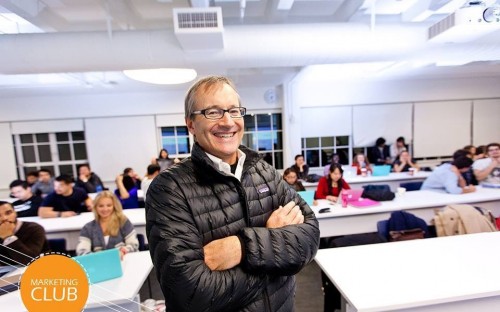What are your club’s big aims this year?
To bring in subject matter experts from different marketing specialties to go into further detail of areas that our courses do not cover. Also to educate other Hult programs (International Business, MBA, Finance, and Social Entrepreneurship) about marketing that is not covered in their curriculum.
Who was the most exciting speaker you had this year?
"Personal Branding with Charlie Sheppard"
Hult professor, Charlie Sheppard, spoke to the Hult Marketing Club on November 13th about taking control of your personal brand. Charlie Sheppard leads Sheppard Partners, a management and organizational development consulting company that focuses its efforts on helping organizations create high performance cultures. By developing innovative technologies and delivering creative solutions, Sheppard Partners provides services in leadership development, the creation of effective teams, and in ongoing organizational development. Charlie coordinates the activities of Sheppard Partners consultants and serves the firm as the lead developer of assessment technologies and courseware. Throughout his career he has been consistently exploring patterns of excellence in human behavior.
What companies are you partnering with?
We have partnered with Hult clubs: Hult Venture Group, Hult Event Management, and Hult SF Net Impact.
Have there been any significant improvements since the 1970s to Kotler’s 4P model (product, place, promotion, price) for analyzing any marketing situation?
Since that model, three more Ps have been introduced: packaging, positioning, and people. "People" has become the most significant change to our traditional model. It goes back to Porter's Value Chain, which has also had an upgrade to "Value Chain 2.0", which involves the "ConsumActor". Meaning, the consumer plays an active role in all angles of the business. Social media has allowed consumers a way to interact with brands. The Voice of the Customer has a greater impact since it allows customers to speak to massive groups of people that are segmented by interest. It has also affected the way PR departments react to negative criticism.
How do you think online shopping has changed the rules of the game in terms of advertising and pricing?
Online shopping has radically changed pricing structures. With a five minute search, you can find dozens of prices for any product. In the past, to do the same comparison you'd spend all day driving around town collecting prices. It is difficult for stores to say they are the lowest price now, because the consumer is usually able to find it lower online. Many of these traditional stores have agreed to match online prices in order to get the business and keep brand loyalists.
Advertising for online stores is done craftly through email and banner ads that follow your computers cookies. For example, if you're looking at a dress from Nordstrom online, then jump over to Facebook, the ads will display that Nordstrom dress. By having this repetitive advertising, consumers are more likely to buy. Yes, it has even worked on me, the marketer! Investing in Google AdWords will allow advertisers to be on the top search results when consumers are looking for something specific, but not exactly sure where to go first, so they turn to Google's search engine. Advertising has become much more of an online game, than offline. Digital marketing budgets are getting greater, because organizations are noticing the effects. Online advertising is becoming more segmented and customized to the consumer. In turn, the Marketing ROI is providing higher yields.
RECAPTHA :
66
3d
48
79







